Misseri-calendar: A Calendar Embedded in Icelandic Nature, Society, and Culture
Introduction
Ethnomathematics exists in one form or another in all societies. Its subjects are the topics of everyday life: they concern nourishment, space, and time. This article recounts how the settlers of the uninhabited Iceland created their own calendar to keep track of time.
Iceland was settled from Norway by Vikings in the latter half of the ninth century, bringing with them Celtic slaves. Icelanders became literate in the twelfth century and soon began to write voluminously, initially to document the laws of the newly-founded Commonwealth [1]. The settlers brought with them the Norwegian traditions of sheep and cattle farming, the seven-day week, and an empirical lunar calendar.
Placed so far from other inhabitancies, the Icelandic settlers had to create their own calendar of the year, based on their heritage of counting time in weeks and on their observation of Nature. A thirteenth-century law-codex, Grágás [2], contains a concise description of a week-based calendar, originally created in Iceland in the tenth century. Observations of the solar cycle soon revealed errors in the original 52-week calendar, which were cleverly amended. The resulting calendar, called the misseri-calendar or farming calendar, was synchronized to the Julian calendar in the twelfth century and later to the Gregorian calendar.
The misseri-calendar remained in common use in Iceland for secular purposes until the nineteenth century. Remnants of the misseri-calendar have survived in the country to the present day, and the calendar gave rise to midwinter-feasts and the First Summer Day as a public holiday. The misseri-calendar system is embedded in the ethnic language and serves to link generations together in their views of time and Nature.
Outline
The first part of the article explains the creation of the pagan calendar invented in Iceland in medieval times and its gradual adaptations to observed changes in Nature. Secondly, the article describes the domestic calendar’s compatibility with the calendar of the Roman Church and a discovery of errors in the Christian calendar. Finally, some discussion ideas for the classroom are included at the end of the article.
The article addresses the questions of why the errors in the original calendar became obvious only a few years after its adoption, how the problem was fixed, and why it was so urgent to fix it. Furthermore, it describes the problem and challenges of adjusting the pagan calendar to the Julian calendar.
[1] Kristjánsson, J. 1980. Icelandic Sagas and Manuscripts, p. 29. Reykjavík: Iceland Review.
[2] Grágás. Konungsbók. Laws of early Iceland: Grágás, the Codex Regius of Grágás, with material from other manuscripts. 1980–2000. Translated by A. Dennis, P. Foote, R. Perkins. Winnipeg: University of Manitoba Press.
Misseri-calendar - The Icelandic Week-based Calendar
Certain calendar features were familiar to all the settlers, who mainly came from the fiords of Western Norway, with slaves from Ireland and the British Isles. These features included a seven-day week [3], with several of the days named after Norse gods that in turn correspond to Roman gods whose names remain visible in the weekday names of some Roman languages.
-
Sunday, the day of the sun
-
Monday, the day of the moon
-
Tuesday for Tyr, the god of war
-
Wednesday for Woden, the cunning god
-
Thursday for Thor, the thunder god
-
Friday for Freyr / Freyja / Frigg, the god and goddesses of love and marriage
-
Saturday, laugardagur, the day of bathing.
The names related to the pagan gods remain even today in English and most Nordic languages. In Icelandic, they were abandoned by the Church in the twelfth century in favor of the names thridjudagur (Third Day) for Tuesday, midvikudagur (Mid-week Day) as in German for Wednesday, fimmtudagur (Fifth Day) for Thursday, and föstudagur (Fast Day) for Friday. Together with the names sunnudagur, manudagur, and laugardagur for Sunday, Monday, and Saturday, these names have remained intact to this day.
Initially, some of the illiterate settlers probably also tried to count time according to the cycle of the moon, 29.53 days, but by the end of the settlement period in year 930 the months were standardized to 30 days each. Although there is no definitive written evidence as to why Icelanders abandoned the lunar months, reflecting on the visibility of the moon as an inhabitant of Iceland suggests several plausible speculations. For example, the moon is often low in the sky at northern latitudes, and the sky itself is frequently cloudy. The nights in Iceland also remain light from April until late August, so that the moon can rarely be seen in the summer, even when it is full. Reasons such as these may explain why counting the lunar months in summer was abandoned, and counting the summer weeks was instead adopted. Moreover, frequent low-pressure areas visiting Iceland cause the sky to be covered with clouds for long periods of time in wintertime, as well as in summer. The fact that the moon cannot be seen regularly in winter due to these difficult weather conditions may also have contributed to the eventual standardization of the winter months to 30 days each [4].
Íslendingabók [The Book of Icelanders, Libellum Islandorum] was written by Ari the Learned in the period 1122–1133. It survives in manuscripts from the seventeenth century. According to this book, an agreement was reached at the yearly parliamentary gathering in the year 930 to meet again after 52 weeks, or twelve 30-day months and four extra nights. Timekeeping by means of counting the weeks and the standardization to 30-day months appears thus to have been formally agreed upon simultaneously. In accordance with this new calendar, the year was divided into two terms, or misseri, with the summer-misseri to last six months, the winter-misseri to last another six months, and four extra nights to be added at midsummer [5]. The year began with the summer-misseri, which began on the First Summer Day (presently in the latter half of April). Interestingly, computing time by counting the 30-day remained a stronger habit among the general public through the centuries during the winter-misseri from January to May than it did during the summer-misseri.
The error in this system of computing time with a 364 day-long calendar year was quickly realized. By the 950s it had become clear that the summer “moved back towards the spring,” i.e. the summer according to this calendar began earlier and earlier vis-à-vis the natural summer. This was inconvenient, as the parliamentary gathering had to assemble after the completion of certain necessary farming tasks, such as lamb-births, and before others, such as hay-making, were due to begin. This problem and the discovery of a possible solution are recorded in The Book of Icelanders (all Icelandic passages in this article have been translated by the author) [5]:
This was when the wisest men of the country had counted in two misseris 364 days – that is 52 weeks, but twelve thirty-night months and four extra days – then they observed from the motion of the sun that the summer moved back towards the spring; but nobody could tell them that there is one day more in two semesters than can be measured by whole weeks, and that was the reason. But there was a man called Thorsteinn Surtur … when they came to the Althing then he sought the remedy … that every seventh summer a week should be added and [they would] try how that would work …
The error might have been realized by Thorsteinn Surtur from observations of the location of the sunset, which in northern areas moves clockwise along the horizon before the summer solstice, and subsequently anti-clockwise. Below, we see the view to the west from Thorsteinn Surtur’s farm at 65° N latitude. Only at summer solstice does the sun set just north (just to the right) of Eyrarfjall [6]. Simulations of the Sun track (or Sun path) related to this phenomenon are described in the next section of this article.
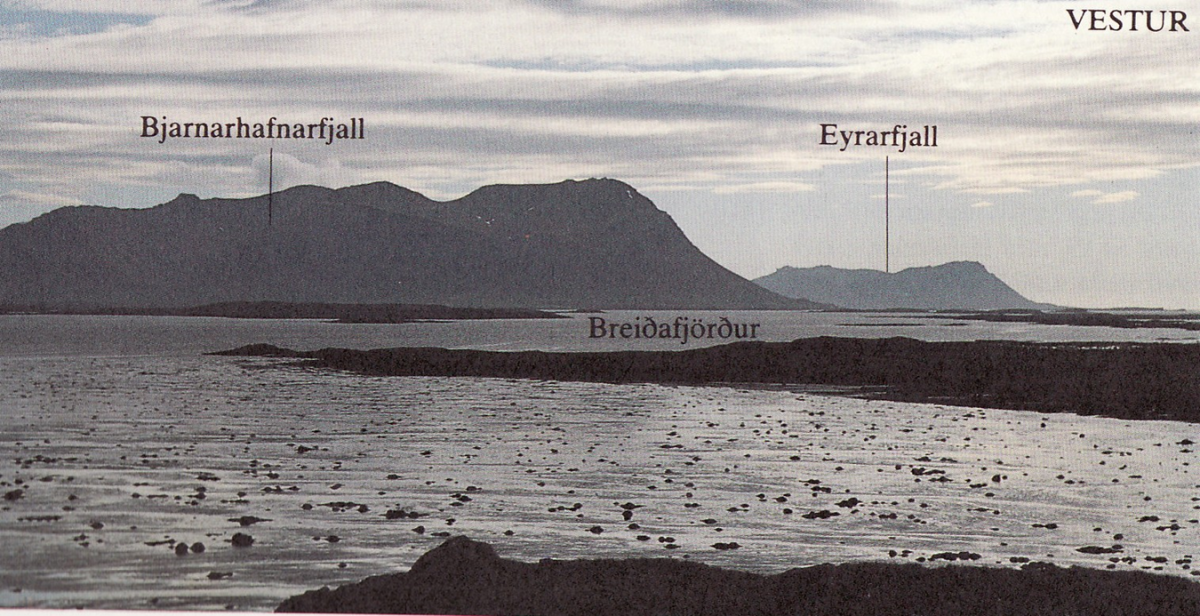
Figure 1: The view to the west from Thorsteinn Surtur’s farm at 65° N latitude.
(Photographer: Grétar Eiríksson)
According to the source cited above [6], Thorsteinn Surtur recommended in year 955 that every seventh year an extra week be inserted at midsummer, Summer’s Extra Week, making the average year 365 days. By the year 1000, the parliament gathered after ten weeks of summer had passed, instead of nine weeks, an adjustment that was needed because the eleven leap years since the year 955 had also caused another, but slower, “move back towards the spring.” The Book of Icelanders says simply [7]:
Then it was spoken the previous summer by law, that men should arrive at Althingi when ten weeks of summer had passed, but until then it had been a week earlier.
[3] Björnsson, Á. 1993. Saga daganna, pp. 18–19. Reykjavík: Almenna bókafélagið.
[4] Richards, E. G. 1998. Mapping Time: The Calendar and its History, p. 204. Oxford: Oxford University Press 1998.
[5] Benediktsson, J. (ed.), 1968. Íslendingabók. Íslensk fornrit I, 1. pp. 9–11. Reykjavík: Hið íslenska fornritafélag.
[6] Vilhjálmsson, Th. 1990. Raunvísindi á miðöldum. In Frosti F. Jóhannsson (ed.). Íslensk Þjóðmenning VII. Alþýðuvísindi. Raunvísindi og dulfræði, pp. 1–50, 271–273. Reykjavík: Þjóðsaga.
[7] Benediktsson, 1968, p. 15.
Misseri-calendar - Simulation of the Sun Track
The axial tilt of the Earth is the angle between the Earth’s rotational axis and the normal vector to the orbital plane around the sun. The axial tilt is currently about 23.44°. The axis remains tilted in the same direction throughout the year; however, as the Earth orbits the Sun, the hemisphere tilted away from the Sun will gradually become tilted towards the Sun, and vice versa. Whichever hemisphere is currently tilted toward the Sun experiences more hours of sunlight each day. In the northern hemisphere, the maximum tilting towards the Sun is at summer solstice in June and the minimum at winter solstice in December. At equinoxes in September and March, the axial tilt does not have an effect on the observed Sun track.

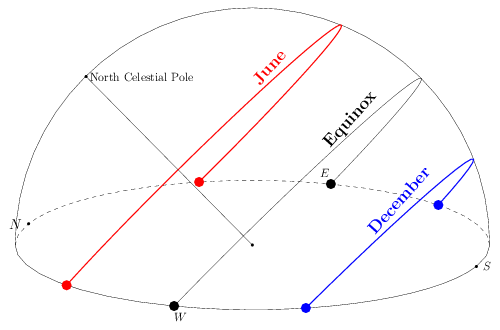
As viewed from Iceland (65° N.) As viewed from Rome (42° N.)
Figure 2: Sun’s path in the sky, with points of sunrise and sunset, at June solstice (red), equinox (black), and December solstice (blue)
Figure 2 shows the paths of the Sun in the sky at the solstices and equinoxes as viewed from Iceland (65° N.) and Rome (42° N.). The horizontal circle denotes the horizon. The further north the location is situated, the greater is the inclination of the Sun’s path with respect to the horizon. At the June solstice, the Sun’s path as viewed in Iceland begins and ends further north, and the visible path of the Sun is therefore longer than it is when viewed in Rome on this same date. In contrast, the visible path of the Sun at the December solstice is shorter when viewed in Iceland than it is when viewed in Rome.
Click here for a simulation showing how the declination of the Sun varies over the course of a year
(from the Astronomy Education at the University of Nebraska-Lincoln website).
(Note: Animation requires the Flash plug-in, included for instance in the Google Chrome browser.)

We will now model the observed Sun track at 65° North, the latitude of the farm of Thorsteinn Surtur, and for comparison at 42° North, the latitude of Rome. The Mediterranean area was considered the middle of the Earth in medieval times, and Rome was the center of the Christian Church that decided upon the official calendar of the Western World. In Figure 3, the altitudes of the Sun at 65°N and 42°N through 24 hours at equinoxes in March and September are approximated by the functions:
\[{\rm{Iceland}}(x) = - (90 - 65) \cos\left (\frac{2\pi x}{360} \right )\]
\[{\rm{Rome}}(x) = - (90 - 42)\cos\left (\frac{2\pi x}{360} \right )\]
The 0°–360° scale on the horizontal axis denotes the placement of the Sun on the 360° horizon (the azimuth) during 24 hours, while the scale on the vertical axis denotes the altitude in degrees.
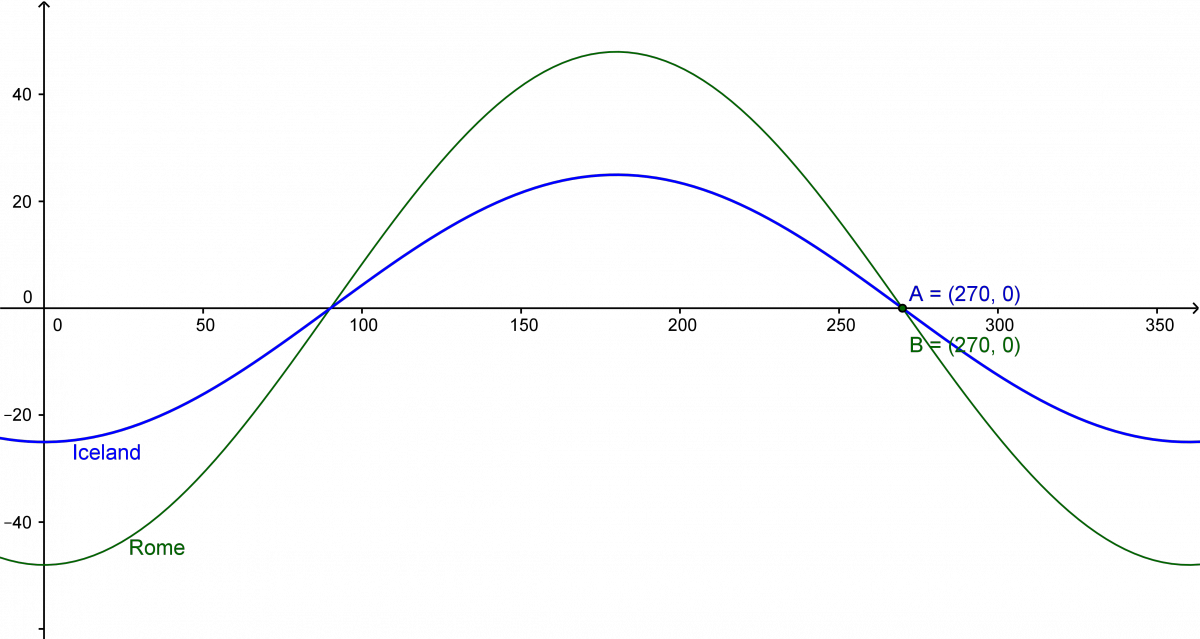
Figure 3: Simulation of the Sun track seen from Iceland at 65°N and from Rome at 42°N at equinoxes in March and September; points A and B show location of sunsets for each location.
Figures 4 and 5 show simulations of the Sun track at the two solstices.
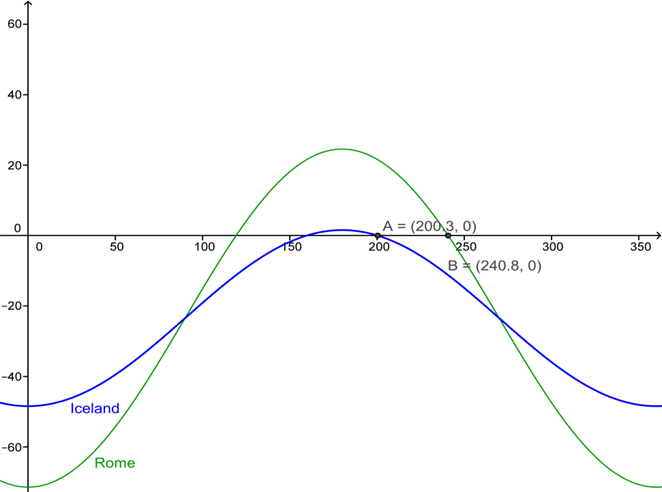
Figure 4: Simulated tracks of the Sun, seen from Iceland at 65°N and Rome at 42°N, at winter solstice when the declination, –23.44°, is subtracted from formulas for altitude of the Sun at equinoxes.
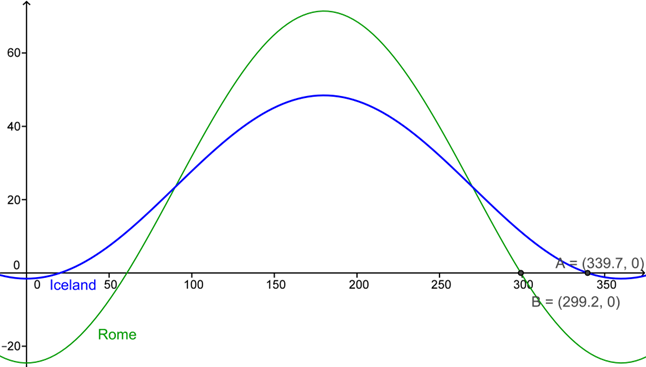
Figure 5: Simulated tracks of the Sun, seen from 65°N and from Rome at 42°N, at summer solstice when the declination, +23.44°, is added to formulas for altitude of the Sun at equinoxes.
We notice in all three models that the track of the Sun is flatter at northern latitudes than it is closer to the equator. At winter solstice the sunset in Iceland at 65°N is at 200° on the horizon, while at summer solstice the sunset is at 340° (see Figures 4 and 5). The range of the sunset in Iceland during half a year is therefore about 140° out of the 180° possible range. For comparison, the approximated sunset in Rome at 42°N at winter solstice is at 241° on the horizon, and at summer-solstice it is at 300°. The range in Rome is thus only about 60°.
Notice also that the altitude of the Sun at 65°N at noon is 90°– 65° = 25° at the equinoxes (Figure 3). At summer solstice (Figure 5), the Sun’s altitude in Iceland is therefore 25°+ 23.4° = 48.4° at its highest position at noon, and the Sun is only –25°+ 23.4° = –1.6° below the horizon at its lowest position in the night. Since the Sun is so close to the horizon at that time, the night is bright. The official calendar for Iceland does not record darkness at 65°N from May 21 until July 23 [8]. For the same reason, in the wintertime when the Sun is only seen for a few hours a day, dawn breaks well before sunrise, and darkness does not fall right after sunset, thus extending the daylight time.
As the track of the Sun is flatter at northern latitudes than at those closer to the equator, the sunsets move faster along the horizon there than at places closer to the equator. The difference in the sunset location over the course of a week or two is much larger in Iceland at 65° than in Rome at 42°. The difference in June for a one degree difference in declination is about 1.4° in Rome (see the coordinates of points B and D in Figure 6), while at 65°N latitude the difference is nearly 6° (see coordinates A and C in Figure 6).

Figure 6. Placement of sunsets at 22.4° declination, and at maximum declination 23.4°.
This may easily be seen from many places on the west coast of Iceland, e.g. from Öskjuhlíð Hill in Reykjavík, as shown in Figure 7.
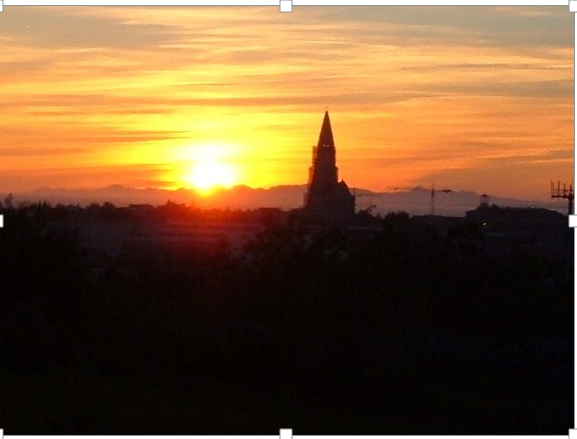

Figure 7. Photographs of sunset on June 11 2008 at 23:55 (left) and on June 19 2008 at 24:04 (right), taken from Öskjuhlíð Hill in Reykjavík, Iceland, at 64° North. (Photographer: The author)
The sunset moved 2.2° clockwise along the horizon in 8 days in June 2008. The situation in nature cannot be compared computationally to the models drawn above, as refractions in the air have to be taken into account. However, the pictures in Figure 7 illustrate how Thorsteinn Surtur may have discovered (in the year 955) the error in the calendar first adopted in the year 930.
Click here for a simulation showing how the direction in which the position of the Sun at sunrise or sunset changes over the course of the year
(from the Astronomy Education at the University of Nebraska-Lincoln website).
(Note: Animation requires the Flash plug-in, included for instance in the Google Chrome browser.)

[8] Almanak fyrir Ísland 2015. Reykjavík: University of Iceland.
Misseri-calendar - Discovery of Errors in the Christian Calendar
Icelanders agreed to accept the Christian Faith in the year 1000. The Icelandic Christian Church as an institution was established in the late eleventh and early twelfth century. The Church introduced into Iceland the Julian calendar, with one extra day added to the usual 365 days every fourth year, the leap year. The Julian calendar was introduced by Julius Caesar in 46 BCE. It was the predominant calendar in the Roman world, in most of Europe, and in later European settlements in the Americas and elsewhere.
In order to make the misseri-calendar fully compatible with the Roman calendar, the Summer’s Extra Week was inserted into the misseri-calendar every sixth year, or every fifth year if two leap years were in-between. It was inserted in midsummer, beginning on Sunday after 13 weeks, and was adjusted so that summer always began on Thursday between April 9 and 15.
By adding a day to 365 days every fourth year, the average length of the year became 365.25 days, while in reality it is approximately 365.2422 days. The Julian calendar assumed the summer solstice to be on June 21, as decided in Nicaea in 325 CE. In the twelfth century, it fell on June 15. This was due to the addition of six too many leap-year days which would have been skipped at years 500, 600, 700, 900, 1000, and 1100 according to a later correction of the calendar, called the Gregorian calendar.
In the first half of the twelfth century, a farm-worker, Oddi Helgason (1070/80–1140/50), called Star-Oddi, made observations of the annual motion of the Sun. An account of his observations is found in the ancient treatise Odda-tala [Oddi’s Tale], contained as a separate treatise in the oldest part of the manuscript GKS 1812, 4to, written around 1192 [9]. The Icelandic week-based misseri-calendar was adjusted to the Julian calendar in the early twelfth century, during Oddi's time. Oddi observed the summer solstice and the winter solstice to be earlier than the official date, i.e. on June 15 and December 15 instead of June 21 and December 21 [10]. The author(s) of the Icelandic calendar treatise, Rím II [rím: rhyme, meaning calendar] [11], writing in the late thirteenth century, compared the summer solstice in Iceland with that "in the middle of the world," the Mediterranean [Mid-Earth] Sea, as follows [12]:
Solstice in summer is four nights before the mass of John the Baptist ... It is so in the middle of the world. Some men say that it is close to a week earlier in Iceland.
The error of the Julian calendar had thus been discovered in Iceland in the twelfth century, but its size seems to have been believed to depend on latitude. No amendments were made to the Icelandic misseri-calendar until year 1700 when the Gregorian calendar was adopted in the Danish realm, Iceland included. From then on, the First Summer Day has fallen on Thursday between April 19 and 25. The two calendars were printed parallel to each other in Dactylismus [13], where Bishop Jón Árnason in 1739 cleverly adjusted the misseri-calendar to the Gregorian calendar.

Figure 8. Celebration of First Summer Day. (Photographer unknown)
[9] GKS 1812 4to [quarto]. The Árni Magnússon Institute for Icelandic Studies, manuscript collection, Reykjavík.
[10] Vilhjálmsson, Th. 1991. Time-Reckoning in Iceland before Literacy. In C. L. N. Ruggles (Ed.), Archaeoastronomy in the 1990s, 69–76. Loughborough, UK, Group D Publications. Available at http://www.raunvis.hi.is/~thv/time.html.
[11] Beckman, N., and Kr. Kålund (Ed.). 1914–1916. Alfræði Íslenzk. Islandsk encyklopædisk Litteratur. II Rímtöl, pp.83–178. Copenhagen: STUAGNL.
[12] Beckman and Kålund, 1914–1916, p. 121.
[13] Árnason, J. 1838; 1946. Dactylismus Ecclesiasticus eður Fingra-Rím. Originally printed in 1739, reprinted in 1838, photocopied in 1946. Copenhagen: P. Jónsson. Available at HathiTrust Digital Library: https://catalog.hathitrust.org/Record/011619269
Misseri-calendar - Concluding Remarks
The well-known Brazilian ethnomathematician Ubiratan D’Ambrosio has suggested an answer to why we should study ethnomathematics [14]:
It may compatibilize cultural forms – we should incorporate ethnomathematics in such a way that they facilitate the acquisition of knowledge, understanding, and the compatibilization of known and current popular practices.
The misseri-calendar was successfully made compatible with the Julian calendar of the Christian world in the twelfth century and further successfully made compatible with the Gregorian calendar in 1739. This tradition was continued in Iceland Almanac [15] in the nineteenth century and it still survives today.
Literature, phrases, and proverbs preserve tradition in the language and culture, and link the present with the past by referring to human experiences, independent of time and space. During periods of rapid change, it is of great value to make the old compatible with the new in order to link generations together.
[14] D’Ambrosio, U. 1985. Socio-cultural bases for mathematics education, p. 70. Unicamp, Campinas.
[15] Almanak fyrir Ísland 2015. Reykjavík: University of Iceland.
Misseri-calendar - Ideas for the Classroom
In this section, we propose some ideas for bringing the history of the misseri-calendar to the classroom.
-
For instance, an interesting question for students to consider is why the use of the misseri-calendar survived for as long as it did. Some possible answers to this question include the following:
-
It had been in use for two centuries before the introduction of the Christian calendar.
-
It was maintained as a secular calendar by law, contained in the oldest collection of laws, Grágás [16], registered in a mid-thirteenth-century manuscript Konungsbók. It is thus rooted in the medieval literary heritage which was studied in Iceland through the centuries.
-
In northern latitudes such as in Iceland, the difference between darkness in winter and brightness in summer is extreme. Celebrating midwinter and First Summer Day and counting the weeks in-between is a tribute to the light and is intimately related to life in northern Nature.
-
-
The habit of counting the years in whole weeks and the need to insert the Summer’s Extra Week every fifth or sixth year, may also interest students. They might, for example, work out the number of days during a 40-year period, called the Solar Cycle, in the misseri-calendar, and compare it to the number of days in 40 years using the regular Roman calendar.
-
Modeling the track of the Sun using the graph of a cosine function with the aid of graphical software, such as GeoGebra, offers a variety of options. Students might draw graphs of the Sun track at their particular latitude at different times of the year. They could then compare the actual times of sunrise and sunset to their models after taking the geographical environment into account. They could also compare their results to those for Iceland or Rome. The formula that is used in this paper is adjusted to northern latitudes: \[f(x) =\, – (90\, –\mbox{latitude})\cos\left (\frac{2\pi}{360}x \right).\] At summer and winter solstices, this formula becomes, respectively, \[f(x) =\, – (90\, –\mbox{latitude})\cos\left (\left (\frac{2\pi}{360}+23.44 \right)x \right)\] and \[f(x) =\, – (90\, –\mbox{latitude})\cos\left (\left (\frac{2\pi}{360} -23.44 \right)x \right).\] These formulas can easily be adapted to southern latitudes. A more advanced student project would be to determine the accuracy of these simulated paths in comparison to the sun’s actual path using formulas from spherical trigonometry.
-
E. G. Richards [17] recounted many calendars used at various times and places around the world. For instance, he described a prehistoric calendar from the Neolithic age (4500–2200 BC) that was postulated by Alexander Thom based on alignments found in megalith structures in various parts of Britain [18]. In particular, sunrise alignments within a megalith could be used to identify the solstices, as well as two particular days surrounding each solstice, one occurring about 23 days before a solstice and the second about 23 days after it. Accordingly, the re-constructed calendar divided the year into 16 months of about 23 days each, but not all of equal length. After being given this information, students could be asked to determine possible divisions of the year that would correspond to such a calendar. Decisions to be made would include deciding when the year would begin (i.e., when "Month 1" begins relative to our current calendar), where the solstices and equinoxes would fall, and which particular months would be shorter (or longer) than 23 days in order to give the entire solar year [19]. As an extension, students might also be asked to consider the problem of ensuring their calendar was constructed in such a way that a reasonable approximation to the average of 365.2422 days in a solar year was reached in an acceptable number of years, possibly by inserting a month at a regular interval, or regularly adding a day to one of the months.
-
Teachers might also wish to discuss with their students the history of calendars and timekeeping more generally, and the misseri-calendar in particular. For instance, students could research the origins of English words, phrases, and proverbs related to various systems of timekeeping.

Figure 8. The famous megalith Stonehenge at sunrise on July 30, 2007.
[16] Grágás. Konungsbók. Laws of early Iceland: Grágás, the Codex Regius of Grágás, with material from other manuscripts. 1980–2000. Translated by A. Dennis, P. Foote, R. Perkins. Winnipeg: University of Manitoba Press.
[17] Richards, E. G. 1998. Mapping Time. The Calendar and its History, p. 141-144. Oxford: Oxford University Press 1998.
[18] Thom, Alexander, Megalithic sites in Britain, Clarendon Press, Oxford, 1967.
[19] Richards, p. 142, provides a table illustrating Thom’s hypothetical division of the year.
Misseri-calendar - Literature Review and References
Mapping time: The calendar and its history by E. G. Richards, is a comprehensive overview of the calendar in theory, calendars of the world, calendar conversions, and computations of dates of Easter. It mentions briefly the Icelandic misseri-calendar when the author explains the geographical difficulties involved in using lunar calendars, as was done by Teutons, including the Angles, Saxons, and Vikings (Richards 1998, pp. 203-205).
Svante Janson has written a scientific analysis of the Icelandic calendar from earliest times (Janson 2011). Janson based his work partly on research by physicist and science historian Vilhjálmsson (see Vilhjálmsson 1990, 1991). See also GKS 1812 4to on medieval Icelandic sources.
The handbook, Bishop Árnason’s Dactylismus Ecclesiasticus eður Fingra-Rím, is a valuable source on the farming calendar.
Furthermore, the current article includes extracts from two additional papers (Bjarnadóttir 2010, 2015) on the Icelandic calendar by its author.
References
Almanak fyrir Ísland 2015. Reykjavík: University of Iceland.
GKS 1812 4to [quarto]. The Árni Magnússon Institute for Icelandic Studies, manuscript collection, Reykjavík.
Grágás. Konungsbók. Laws of early Iceland: Grágás, the Codex Regius of Grágás, with material from other manuscripts. 1980–2000.Translated by A. Dennis, P. Foote, R. Perkins. Winnipeg: University of Manitoba Press.
Árnason, J. 1838; 1946. Dactylismus Ecclesiasticus eður Fingra-Rím. Originally printed in 1739, reprinted in 1838, photocopied in 1946. Copenhagen: P. Jónsson. Available at HathiTrust Digital Library: https://catalog.hathitrust.org/Record/011619269
Beckman, N., and Kr. Kålund (Ed.). 1914–1916. Alfræði Íslenzk. Islandsk encyklopædisk Litteratur. II Rímtöl, pp.83–178. Copenhagen: STUAGNL.
Benediktsson, J. (ed.), 1968. Íslendingabók. Íslensk fornrit I, 1. Reykjavík: Hið íslenska fornritafélag.
Bjarnadóttir, K. 2010. Ethnomathematics at the margin of Europe – A pagan calendar. Journal of Mathematics and Culture, 5(1). Available at http://nasgem.rpi.edu/pl/journal-mathematics-culture-volume-5-number-1.
Bjarnadóttir, K. 2015. Calendars and Currency – Embedded in Culture, Nature, Society and Language. History and Epistemology in Mathematics Education. Proceedings of the 7th European Summer University, ESU 7, pp. 605 – 624. Copenhagen: Aarhus University: Danish School of Education.
Björnsson, Á. 1993. Saga daganna. Reykjavík: Almenna bókafélagið.
D’Ambrosio, U. 1985. Socio-cultural bases for mathematics education. Unicamp, Campinas.
Janson, S. 2011. The Icelandic calendar. Scripta Islandica, Isländska Sällskapets årsbok 62/2011, pp. 51-104. Uppsala.
Kristjánsson, J. 1980. Icelandic Sagas and Manuscripts. Reykjavík: Iceland Review.
Richards, E. G. 1998. Mapping Time: The Calendar and its History, Oxford: Oxford University Press 199
Thom, Alexander, Megalithic sites in Britain, Clarendon Press, Oxford, 1967.
Vilhjálmsson, Th. 1990. Raunvísindi á miðöldum. In Frosti F. Jóhannsson (Ed.). Íslensk Þjóðmenning VII. Alþýðuvísindi. Raunvísindi og dulfræði, pp. 1–50, 271–273. Reykjavík: Þjóðsaga.
Vilhjálmsson, Th. 1991. Time-Reckoning in Iceland before Literacy. In C. L. N. Ruggles (Ed.), Archaeoastronomy in the 1990s, 69–76. Loughborough, UK, Group D Publications. Available at http://www.raunvis.hi.is/~thv/time.html.
Misseri-calendar - Acknowledgements and About the Author
Acknowledgements
The author wishes to thank the editors of Convergence, Janet Heine Barnett in particular, and the referees, for invaluable assistance in improving this article. She also wishes to thank Th. Vilhjálmsson, Professor Emeritus, University of Iceland, for allowing the use of the photograph in Figure 1, and Dr. George W. Heine III, for creating the diagrams in Figure 2.
About the Author
Kristín Bjarnadóttir is professor emerita in mathematics education at the University of Iceland. Her research interests include the history of mathematics education as well as mathematics curricula and instruction at the secondary school level. She enjoys hiking together with old friends from Girl Scouting and Boy Scouting.
